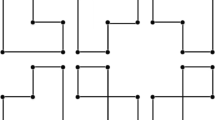Abstract
In this paper, two new methods to construct low-density parity-check (LDPC) codes with low error floor and large girth are proposed. The first one is APPS-LDPC codes based on Arithmetic Progression theory and cycle classification, whose girth is at least eight. Based on the designed APPS-LDPC codes, we further construct Bi-diagonal APPS-LDPC codes with column degree 4, whose circulant permutation matrix is combined by two shifted identity matrix. The designed APPS-LDPC code has 0.25 and 0.2 dB coding gain compared to partition-and-shift (PS)-LDPC code and progressive-edge-growth (PEG)-LDPC code. And the Bi-APPS-LDPC code has similar performance to T2 LDPC code in CCSDS standard, but its effective structure is more suitable for high throughput decoder implementation on FPGA. Both codes have less construction complexity than PS-LDPC code and PEG-LDPC code.








Similar content being viewed by others
References
Gallager, R. G. (1963). Low-density parity check codes. Cambridge, MA: MIT Press.
Tanner, R. M. (1981). A recursive approach to low complexity codes. IEEE Transactions on Information Theory, 27(5), 533–547.
Jin, L., & Moura, J. M. F. (2005). Partition-and-shift LDPC codes. IEEE Transactions on Magnetics, 41(10), 2977–2979.
Jin, S., Zhongfeng, W., Minglun, G., & Li, L. (2009). Multi-Gb/s LDPC code design and implementation. IEEE Transactions on Very Large Scale Integration (VLSI) Systems, 17(2), 262–268.
Sunghwan, K., Jong-Seon, N., Habong, C., & Dong-Joon, S. (2007). Quasi-cyclic low-density parity-check codes with girth larger than 12. IEEE Trans on Information Theory, 53(8), 2885–2891.
Jingyu, K., Qin, H., Li, Z., Bo, Z., & Shu, L. (2010). Quasi-cyclic LDPC codes: An algebraic construction. IEEE Transactions on Communications, 58(5), 1383–1396.
Qin, H., Qiuju, D., Shu, L., & Abdel-Ghaffar, K. (2012). Cyclic and quasi-cyclic LDPC codes on constrained parity-check matrices and their trapping sets. IEEE Transactions on Information Theory, 58(5), 2648–2671.
Xiao-Yu, H., Eleftheriou, E., & Arnold, D. M. (2001). Progressive edge-growth Tanner graphs. In Proc. global telecommunications conference, 2001. GLOBECOM ‘01 (pp. 995–1001). IEEE.
Lu, J., Moura, J. M. F., & Niesen, U. PS-LDPC codes: Regular structure and arbitrary girth, submitted for publication.
Milenkovic, O., Kashyap, N., & Leyba, D. (2006). Shortened array codes of large girth. IEEE Transactions on Information Theory, 52(8), 3707–3722.
Guohua, Z., Rong, S., & Xinmei, W. (2013). Several explicit constructions for (3, L) QC-LDPC codes with girth at least eight. IEEE Communications Letters, 17(9), 1822–1825.
CCSDS131.1-0-2. (2007). Low density parity check codes for use in near earth and deep space applications[S]. CCSDS.
Acknowledgements
The authors are grateful to the anonymous reviewers and the support of the National Science Foundation of China (No. 61501479). Meanwhile, the authors would like to thank Hua Zhou for his helpful discussions and comments on this paper.
Author information
Authors and Affiliations
Corresponding author
Additional information
This work is supported by the National Natural Science Foundation of China (No. 61501479).
Rights and permissions
About this article
Cite this article
Li, E., Dong, L. & Lei, J. High Rate APPS and Bi-APPS LDPC Codes Design with Low Error Floor and Large Girth. Wireless Pers Commun 100, 709–720 (2018). https://doi.org/10.1007/s11277-018-5342-0
Published:
Issue Date:
DOI: https://doi.org/10.1007/s11277-018-5342-0




